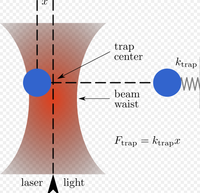








Optical tweezers were invented by Ashkin in 1970. If a laser beam is focussed by a high numerical aperture objective, small objects with an index of refraction higher that the immersion medium are attracted to the focal spot [2,3]. Typically, plastic beads in water will be trapped to the focal spot. This allows one to move them about and thus to manipulate micron-sized objects in a non invasive way just by using a light beam, in a manner reminiscent of the Star Wars “tractor beam”. The trapping effect results from the deflection of the laser light by the bead when it is pushed out of focus by Brownian motion. The laser power required is on the order of a few milliwatts.
In biophysics, Optical Tweezers are used to measure forces. Calibration of the optical trap’s stiffness is done by applying a known external force (such as a hydrodynamic flow or the Langevin force) to the trapped bead and recording the amplitude of its displacement away from the trap focus [4,5,6]. Optical tweezers are natural position clamps, i.e. the position of the bead is clamped to a specified position.
When a strong force is applied to the bead, it can escape from the trap. Thus optical trap may be viewed as a local potential hole. The maximum force is reached typicaly when the bead is pushed out of the trap by a distance coparable to the laser wavelength. At this point, the force varies very little with the position of the bead and the trap becomes a force clamp.